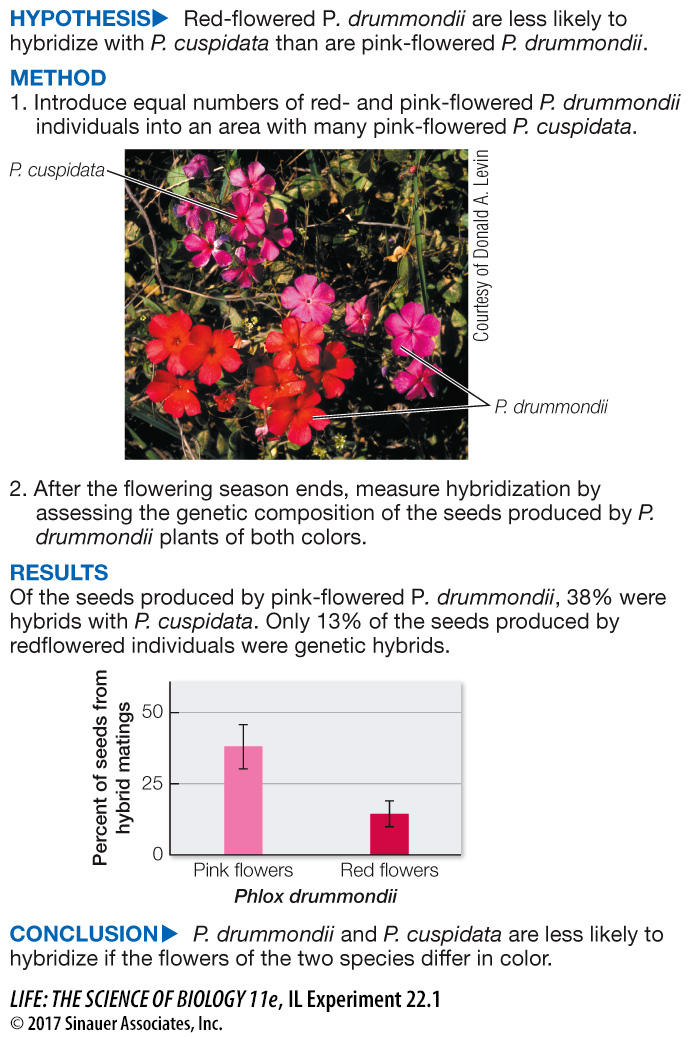Postzygotic isolating mechanisms result in selection against hybridization
Genetic differences that accumulate between two diverging lineages may reduce the survival and reproductive rates of hybrid offspring in any of several ways:
Low hybrid zygote viability. Hybrid zygotes may fail to mature normally, either dying during development or developing phenotypic abnormalities that prevent them from becoming reproductively capable adults.
Low hybrid adult viability. Hybrid offspring may have lower survivorship than non-
hybrid offspring. Hybrid infertility. Hybrids may mature into infertile adults. For example, the offspring of matings between horses and donkeys—
mules— are sterile. Although otherwise healthy, mules produce no descendants.
Natural selection does not directly favor the evolution of postzygotic isolating mechanisms. But if hybrids are less fit, individuals that breed only within their own species will leave more surviving offspring than will individuals that interbreed with another species. Therefore individuals that can avoid interbreeding with members of other species will have a selective advantage, and any trait that contributes to such avoidance will be favored.
Donald Levin of the University of Texas has studied reinforcement of prezygotic isolating mechanisms in flowers of the genus Phlox. Levin noticed that most individuals of P. drummondii in most of the range of the species in Texas have pink flowers. However, where P. drummondii is sympatric with its close relative, the pink-
investigating life
Flower Color Reinforces a Reproductive Barrier in Phlox
experiment
Original Paper: Levin, D. A. 1985. Reproductive character displacement in Phlox. Evolution 39: 1275–
Most Phlox drummondii flowers are pink, but in regions where they are sympatric with P. cuspidata—which is always pink—

work with the data
Donald Levin of the University of Texas proposed that Phlox drummondii has red flowers only in locations where it is sympatric with pink-
| Morph (flower color) | Number of seeds (progeny) | ||
|---|---|---|---|
| P. drummondii | Hybrid | Total | |
| Red | 181 (87%) | 27 (13%) | 208 |
| Pink | 86 (62%) | 53 (38%) | 139 |
QUESTIONS
1.
Check the 95% confidence intervals for the proportion of hybrid seeds in red-
For red flowers, the proportion of seeds from hybrid matings is 0.1298 (27/208). The 95% confidence limits of this proportion are approximately 0.09–0.18.
For pink flowers, the proportion of seeds from hybrid matings is 0.3813 (53/139). The 95% confidence limits of this proportion are approximately 0.30–0.47.
2.
Notice that the proportions of hybrids among the seeds of red-
The null hypothesis is that there is no significant difference in the proportion of hybrid seeds produced from red versus pink flowers. This hypothesis is rejected; the probability that the null hypothesis is true is P < 0.0002.
3.
How would you extend or improve the experimental design of this study? What kinds of additional test sites or conditions would you want to examine? How might replicate or control sites make the study more convincing?
Scientific studies often raise new questions that can be addressed by follow-
A similar work with the data exercise may be assigned in LaunchPad.
Likely cases of reinforcement are often detected by comparing sympatric and allopatric populations of potentially hybridizing species, as in the case of Phlox. If reinforcement is occurring, then sympatric populations of closely related species are expected to evolve more effective prezygotic reproductive barriers than do allopatric populations of the same species. As Figure 22.11 shows, the breeding seasons of sympatric populations of different leopard frog species overlap much less than do those of allopatric populations. Similarly, the frequencies of the frog mating calls illustrated in Figure 22.12 are more divergent in sympatric populations than in allopatric populations. In both cases, there appears to have been natural selection against hybridization in areas of sympatry.